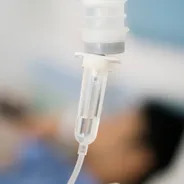Most of us have felt someone else's pain at one time or another. Whether it be a close friend's emotional trauma or a particularly violent scene in a film, many people have had that moment where they've felt chills go down their back; where they're so overcome with empathy that they almost feel like they're experiencing the suffering themselves.
But what if you literally could feel another person's pain? I don't mean in a compassionate, perceptive sort of way, I'm talking about genuinely feeling every ache, wound and illness that they go through. It sounds beyond the bounds of possibility, but incredibly, this is actually a real condition called mirror-touch synesthesia.
Found in approximately 1.6 to 2.5 per cent of the population, when sufferers of the rare condition witness someone else experience pain, or sometimes even just the sense of touch, their brains recreates the sensations in their own bodies. Over 60 different types of synesthesia are known of; these include grapheme-colour, where numbers and letters have colours, and auditory-tactile, where sounds can lead to sensations in the body.
One person who puts himself through more pain than necessary is Dr Joel Salinas, a neurologist at Harvard Medical School and Massachusetts General Hospital, who specialises in brain health and can feel his patients' suffering so knows exactly what they're going through.
Discussing his condition with the BBC, Salinas said that for him it started early, remembering warm "cool silvery blue" sensations when he watched someone being hugged and unpleasant feelings when he watched a person being hit - whether this be in real life or on the TV. "When the cartoon Road Runner stuck out its tongue, I'd feel as if mine was sticking out. When the coyote got hit by a truck, I'd feel it," he said.
His merging senses - which no one could make any sense of at all the time - made things difficult for him in school. "When colouring in at school I was very specific that my B had to be just the right shade of orange and that my number one had to be yellow," he told the news website. "Sums also didn't make intuitive sense to me. My two was a red maternal person and my four was a blue friendly person. So how could a two plus a two equal a four?"
Not only did his mystery condition make certain lessons taxing for him, Salinas also struggled to fit in with his peers and remembers asking his mother why nobody liked him. But even after frequent rejection, the young man knew his future lay in making people feel better. He was drawn to healing others as a result of his synesthesia and decided to pursue a career in medicine. But all didn't go as planned to begin with.
When a patient passed away in front of him at medical school, Salinas realised just how strongly he could experience another's pain. Running to the bathroom to vomit after seeing someone have a cardiac arrest, he had to reassure himself that he wasn't dead.
Speaking to the BBC, he said: "I saw them getting chest compressions and I could feel my back on the linoleum floor and the compressions on my own chest. I felt the breathing tube scraping down the back of my throat."
When the patient was declared dead 30 minutes later, Salinas experienced what he called an "eerie silence," describing it as: "I had this complete absence of physical sensations. It was so haunting. It was like being in a room with an air conditioner and suddenly it was switched off."
On that day, he vowed to himself that he would never react so powerfully to a patient's pain again. Knowing he couldn't do the thing he loved if he didn't learn to control his condition, he sought coping mechanisms and began to focus on his patients' sleeves or collars, or on grounding himself in his own body to get through the experience.
It wasn't until 2007 when he visited a leading expert, neurologist Dr V S Ramachandran, to take part in some tests that Salinas finally got a name for the newly discovered condition. Yet, even now, 11 years later, it is still not fully understood and research is ongoing.
These days, scientists believe that we're all born with synesthesia, with a recent study finding that babies associate different shapes with different colours. Reportedly though, this merging of senses diminishes - for most of us - as our brains remove unnecessary connections in a process known as "pruning".
Yet, although Salinas' "hyper-empathy" often deals him a rough hand in life, it is also undeniably beneficial. Being able to feel a patient's every ailment gives him a unique talent in the medical profession, likely making him the doctor who everyone wants an appointment with.
"I think it's empowered me to really connect with my patients," he said. "There's a wall that's torn down when you feel a lot of the sensations that your patients feel as well."
And despite the unpleasant consequences of living with synesthesia, Dr Salinas said he wouldn't change a thing. "It's part of who I am," he says. "It would be really weird not to have it."










